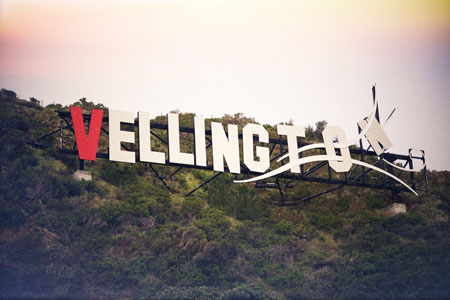directed by Jemaine Clement and Taika Waititi, 2014
by Raqi Syed
September 11, 2014
 It used to be the case that parody was the final signifier by which a genre had become so ubiquitous, its conventions so overplayed, that the only way in which the genre could continue on for another cycle was to spiral in on itself. Films like Cat Ballou, Blazing Saddles, and City Slickers, suggested for a time that the western had gone out of style and only through parody could audiences find relevance in it. Similarly, by the late 90s, the I Know What You Did Last Summer movies and the copycat films which followed, indicated some kind of disenchantment with traditional horror films. In the face of extinction, westerns, gangster films, and musicals stay afloat with a handful of films emerging as homage year after year. But the horror genre has proven to be resilient—I would argue not only because of the continued cultural relevancy of how our audiences collectively respond to fear—but also because it has split off into a series of self-sustaining sub-genres. What We Do in the Shadows proves that horror's degenerative cycle is long behind us, and more importantly, it continues to thrive by opening itself up to the influence of other genres and national cinemas.
It used to be the case that parody was the final signifier by which a genre had become so ubiquitous, its conventions so overplayed, that the only way in which the genre could continue on for another cycle was to spiral in on itself. Films like Cat Ballou, Blazing Saddles, and City Slickers, suggested for a time that the western had gone out of style and only through parody could audiences find relevance in it. Similarly, by the late 90s, the I Know What You Did Last Summer movies and the copycat films which followed, indicated some kind of disenchantment with traditional horror films. In the face of extinction, westerns, gangster films, and musicals stay afloat with a handful of films emerging as homage year after year. But the horror genre has proven to be resilient—I would argue not only because of the continued cultural relevancy of how our audiences collectively respond to fear—but also because it has split off into a series of self-sustaining sub-genres. What We Do in the Shadows proves that horror's degenerative cycle is long behind us, and more importantly, it continues to thrive by opening itself up to the influence of other genres and national cinemas.
With the vampire film averaging about ten features a year ranging from supernatural teen, to European art house, to neo-noir romance, the entrance of What We Do in the Shadows only further solidifies the genre as capable of supporting a myriad of interpretations. There is something about the other among us, the contradictory forces of repulsion and attraction this poses, that is very alluring indeed. Set up as a mockumentary about a group of vampires flatting together in wellington, the film relies on a kind of deadpan, purposefully awkward humor that tv audiences have become increasingly accustomed to. Long pauses, actors stuttering, seemingly unmotivated camera pans, and abrupt cuts, nod to a sensibility well established to those familiar with Jemaine Clement and Taika Waititi's previous work.
The result is a kind of fine lens through which Wellington and Kiwi culture are examined—there are many inside jokes for those who live in Wellington and know its geography—and a simultaneous distanciation through comedy and genre which allows the filmmakers to satirize this culture in a way that feels expansive and internationally relevant. What We Do in the Shadows is not so much a vampire film set in Wellington, as it is an appropriation of popular culture that presents New Zealand to an international audience in a nuanced way. The film seems to very quietly say, New Zealand is not Middle Earth, New Zealand is where we take the tropes of American popular culture and reimagine it as a new kind of global culture. In a country that is known for being home to an international filmmaking community, this becomes a particularly salient point. What does it mean when American culture is manufactured by a community of international artists on the other side of the world? Is it even American culture any more, or is it a kind of post-American culture that is really not American at all? By taking the vampire film, a genre that for a time has come to represent American teen pop culture, What We Do in the Shadows injects new life in the genre and argues for a reevaluation of the ownership of popular culture.
Basquiat—The Unanswerable Answer to the Art World
Let’s talk about the hard stuff: Get Out
May It Last: A Portrait of the Avett Brothers
Move Over Hogwarts—The Practical Magic Is at Headfort
The Dog Days of Summer—Two Ways to Beat the Heat
The Mistress, the Publisher, His Son & His Mother
Santoalla-- the Spaces Between
Reading Arthur Miller in Tehran, The Salesman
Killing the ISIS Propaganda Machine, City of Ghosts
Bewitched, Bothered and Beguiled, The Beguiled– A Film Review
A Spoonful of Sugar-- Not Saccharine The Big Sick: A Film Review
Fiona and the Tramp, Lost in Paris- a review
Movie Review: Beatriz at Dinner
Cameraperson, dir. Kristen Johnson: stories from behind the camera lens
SELFISH, Review by Heather Zises
Winter on Fire: Ukraine’s Fight For Freedom, dir. Evgeniy Afineevsky
Strange Days directed by Kathryn Bigelow (1995)
World of Tomorrow and the Quit-Bang Language of the Future
Quintet, Directed by Robert Altman, 1979
Classic Movie Short Review: Croupier (1998)
